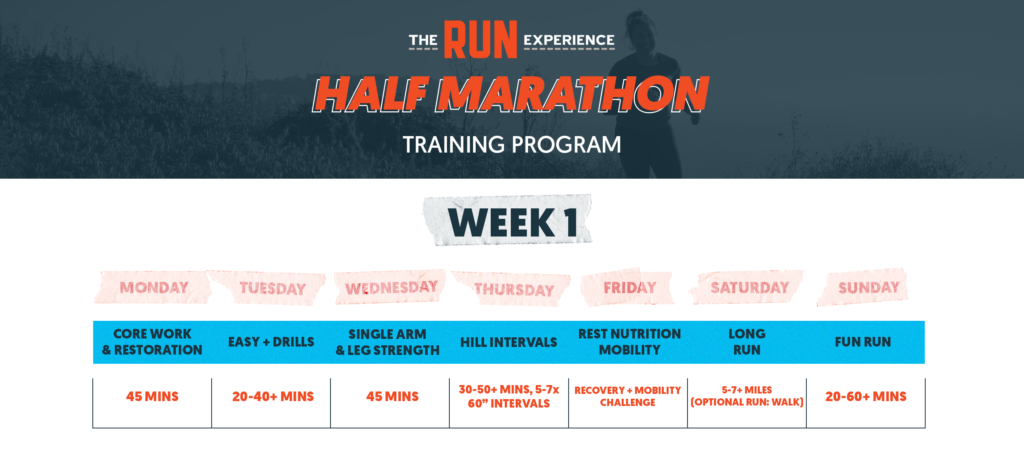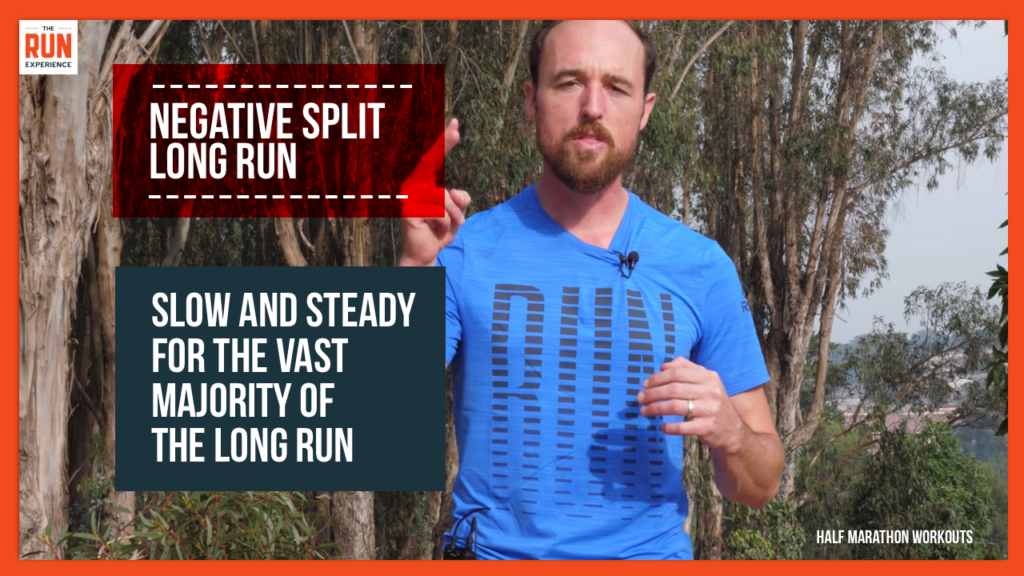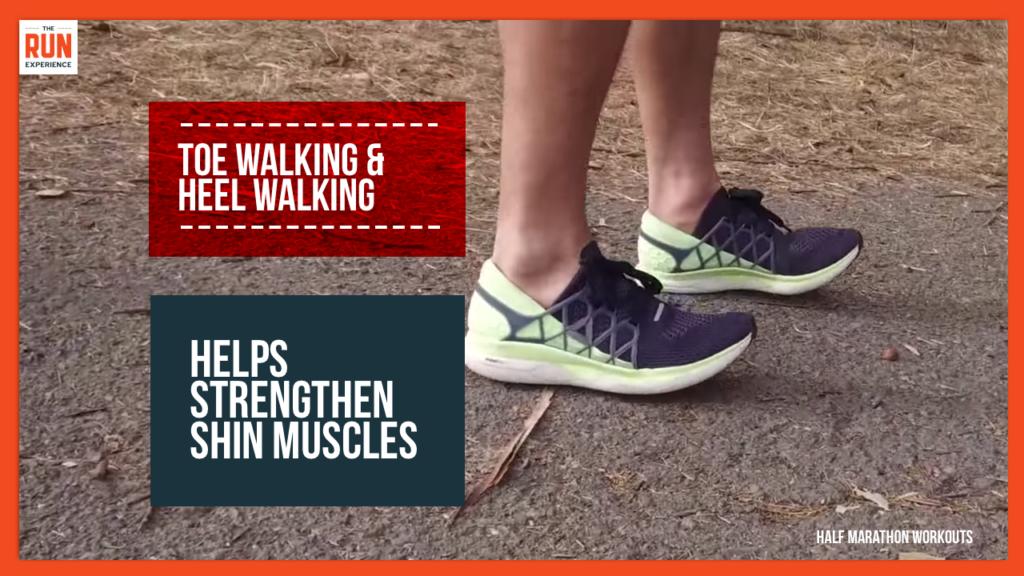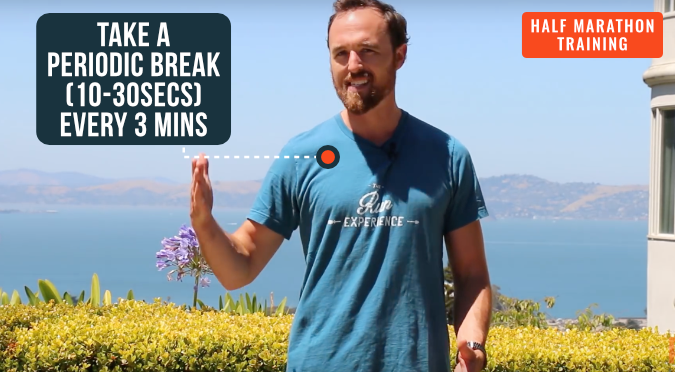Half Marathon Training Plan for Beginners (Couch to Half Marathon)
Go from couch to half marathon with a half marathon training plan for beginners. Use this schedule to build endurance and avoid injury.

Want to run your first half marathon? Or maybe you’re just thinking about the idea of one as a future goal. If you’re not a regular exerciser, the idea of getting from couch to half marathon and crossing the finish line can sound overwhelming.
But it doesn’t have to be. A couch to half marathon goal can be attainable—you simply need to dedicate time to your goal, keep yourself motivated, and commit to a beginner half marathon training plan.
Many half marathon training plans for beginners make the mistake of taking things too quickly. They neglect adaptation, strength, and recovery techniques—and this often leads to runner injury or burnout.
At The Run Experience, we do things differently. Our holistic half marathon training plan for beginners focuses on running, form, cross-training, strength training, mobility, and recovery to ensure you reach the start line and the finish line.
Here’s a half marathon training schedule that will take you from the couch to half marathon starting line on race day.
Couch to Half Marathon With a Half Marathon Training Plan for Beginners

Running a half marathon requires a base-building phase if you’re new to the sport or returning after a layoff. This phase will slowly acclimate your body, help you stick to a training schedule, and give you time to find some cool places to run. Your weekly mileage can stay low as you gradually build up. Using methods such as walk/run/walk is a great way to use short stints of running with a walking recovery built in.
Here at The Run Experience, we have two programs to guide you from ground zero with the Beginner Running Program and the 30 Day Challenge. Both programs are available in our app as a Premium member with full schedules, video instruction, and a running community who is right in there with you. As a beginner, having access to our coaches for your questions can be a particularly valuable tool as you go from couch to half marathon.
Remember, as tempting as it is to jump in head-long and pile on the miles right away, that’s a recipe for disaster. Burnout and injury will most likely catch up to you quickly. Beginner half marathon training isn’t all about piling on as many miles as possible. Better to start off slowly and surely with those gentle run days, cross-training, and recovery days to ensure the longevity of your new challenge.
Read even more training tips here for your first half marathon!
How Long Is a Typical Half Marathon Training Schedule?

As a first-timer, plan for 12 to 16 weeks of training from start to finish. This will allow you to build your endurance, strength, and confidence for the first 4-6 weeks, then complete the eight-week half marathon training plan to bring you right up to race day.
The important things to focus on as you get started (and what you’ll learn in our programs) are:
- Proper running technique and form—with key exercises to optimize the way you run
- How to build running strength—without the need for a gym, so you can run faster and cruise up hills
- Injury prevention—everything you need to know about solving your body’s tight areas, improving your range of motion, and keeping you running consistently
As a beginner runner, you’ll need to learn how to listen to your body. Some aches and pains are expected, but if you are having nagging pain that doesn’t go away or pain that is affecting your running form, take action. Use your rest days to focus on injury prevention techniques such as mobility drills and foam rolling, proper hydration and nutrition, and getting quality sleep.
If you’ve been prone to injury in the past and you know you want to build a self-care routine, we even have an Injury Prevention Series to teach you how to injury-proof all the important areas of a runner’s body—the hips, knees, and ankles being the most common areas. Just check it out in the app!
Where to Start Your Beginner Half Marathon Training
No matter your fitness level, start at a point that your body can handle. If you’re not sure what’s right for you, experiment. Before even looking at what “Day One” of your beginner half marathon training schedule looks like, just go outside.
Try running for 30 seconds followed by walking for a minute. Too easy? Too difficult?
Adjust each interval as it feels appropriate for you. Don’t forget that it can vary from day to day, as well. Some days it might feel like your feet weigh 10 pounds each, and other days you might feel light as a feather. Such is the nature of running!
Try this follow-along workout from Coach Holly when you’re starting out. You’ll get a good warm-up, lots of walk breaks, and beautiful scenery to look at along the way. You’ll also get motivational coaching cues during the times you feel like quitting and finish up with a proper cooldown at the end.
Varied Training Will Help You Nail Your Half Marathon Goals

It’s important to point out that training for a half marathon isn’t just about getting the miles in all at the same pace. In order to facilitate strong muscles and prevent injury, you need to incorporate specific quality workouts such as tempo runs, hill workouts, and speed work. By spending time running at different speeds you’ll tap into different muscles to prevent fatigue, practice charging up gradual inclines, and prevent the boredom of repetitive slow runs. You’ll see these speed workouts built into our Half Marathon Training Plan for Beginners, and Coach Nate will be there to explain the purpose and procedure.
If you’ve looked at couch to half marathon training programs for beginners in the past, chances are you’ve seen X-train or Cross-train listed on there. But what exactly does that look like, and why bother including it in your half marathon training schedule? For us here at The Run Experience, it means including strength training and mobility work.
Bodyweight strength movements such as lunges, push-ups, and core work will all help fortify your body for the impact of running. They’ll also help you learn to move with control and stability through an exaggerated range of motion. When you’re leaning forward in a lunge, you’re building strength through the same movement patterns as running, but with a greater range. The movements will also help build hip strength, midline (core) stability, and better posture, which will allow you to run strong and tall even during tough speed workouts or long distances.
All of these workouts are built into our Half Marathon Training Plan for Beginners, so you won’t be overwhelmed with trying to figure it all out on your own.
Beginner Half Marathon Training Plans
Once you’ve committed to running a half marathon and picked up your new running shoes, it’s time to sign up for a race. Before you pick a program for the half marathon distance, spend one to three months developing a good athletic base, as outlined above.
Once you’re up to 15 to 20 miles a week, pick a race that’s at least eight weeks from the time you start your training. Once you’ve signed up, it’s time to get started with a half marathon training plan.
There is no shortage of half marathon training plans to choose from, but we strongly believe we at The Run Experience have a first-class training program for half marathoners. It will get you to the finish line with the results you want. Here are just a few of the things you join us as a Premium member:
- A scaleable running approach with LIVE running coaching support.
- Four training runs per week (pace and tempo specific), two cross-training days, and one mobility/recovery day.
- Dynamic warm-ups and cooldowns to target mobility, form, and injury prevention.
- In-depth video resources on strength training, injury prevention exercises (a favorite of our members), run technique, and even breathing.
- Access to all our other programs such as Running Strength, 5k Program, Full Marathon Program, and more.
Half Marathon Training Schedule
We’ll dive into the first week of our eight-week Half Marathon Training Schedule here so you can see how we organize our training to include running, cross-training, and mobility throughout the week. In the app, you’ll get a video with full details for each day of training for the half marathon running plan.
Remember, if your fitness level isn’t quite ready for this half marathon running plan, then we still have tons of resources for you! Once you’re a Premium member in the app, you can explore the 30-Day Challenge or the Beginner Running Program we mentioned earlier. Both programs will help you build the base you need before tackling the longer distances.

Day 1: Core Work and Restoration
- Warm-Up: two rounds of:
- 30 jumping jacks + 5 plank walkouts
- 10 squats with a 2-second pause at the bottom + 5 pushups
- 20 leg swings + 10 lunges per side
- repeat for 2 total rounds
- Mainset:
- 3 rounds: 30″ single-arm planks (alternate arms slowly side to side) + 10 V up/tuck up variations
- 3 rounds: 20″ side planks (each side) + 10 happy stars
- 3 rounds: 5-10 downward dog pushups + 10 lateral leg raises “windshield wipers”
- Mobility:
- Chest stretch (on belly). ~2 minutes per side
- Upward dog + downward dog flow ~5-10 reps (or 2 minutes)
- Anterior + posterior banded hip stretch. ~2 minutes per side in each direction
Day 2: Posture, Breathing, and Pulling Drills
- Warm-Up:
- 10 deep belly breaths
- 5-minute easy run to get your heart rate going
- Bend & Touch: stop running and continue warm-up with a bend over and touch and reach back.
- Side Bend: side to side bend.
- Hips: follow with 5 high kick + lateral lunges in each direction.
- Drills:
- Leg swing + Pull: this drill involves a standing leg swing + Pull. 10 each side.
- Pulling: 5 rounds: 30 meters run, pull 10 times on the right, pull 10 times on the left.
- As you pull your leg up, focus on being as tall and relaxed as possible. The taller and more relaxed the easier it is to pull!
- Run:
- Run the remainder of the time at a steady to moderate pace. Every 5 minutes include 10 quick pulls on each side.
- Cool Down & Mobility:
- 3 minutes of easy running
- 2 minutes of couch stretch per leg
Day 3: Strength and Cross-Training
- Warm-Up:
- 3 rounds: 10″ jogging in place, 10″ of high knees, 10″ of butt kicks, and 10″ of rest
- 3 rounds: lateral lunge and hip circles
- 2 rounds: 10 opposite arm circles each way and 3 shoulder rotation (with hand against wall)
- Main Set:
- 3 rounds: 10 meters of walking lunges and forwards bear crawl
- 3 rounds: 10 meters of inchworms and backwards bear crawl
- 3 rounds: 10 single-leg burpees (5 L, 5 R) and 10 step-ups per leg. Choose height on ability.
- 3 rounds: 10 shoulder touch push-ups (touch, touch, pushup) and 10 box or bench jumps. Choose height on ability.
- Mobility:
- 5 minutes quad rolling & smashing
- 5 minutes thoracic spine (upper back) and shoulder work
Day 4: Hill Intervals
- Warm-Up:
- 10 deep belly breaths
- 10 minute run progressing from easy to moderate effort
- 1 round: 10 sprawls, 10 squats, 10 hip circles per leg, 10 elbow touches per side, 10 forward/backward arm swings
- Run:
- 5-7 rounds: 60-second hill interval. Rest 1-2 minutes in between.
- *Use a “runnable” hill, nothing that’s over 5% incline.
- Options: continue up the hill & slow jog back down to the start, or use a treadmill indoors
- Cool Down & Mobility:
- 3 minutes easy run/walk cool down
- 2 minutes of rolling with a ball, per foot
Day 5: Rest and Mobility
- Today is a recovery and restorative day. The goal is to give you the mental and physical break you need to not only absorb all the hard training you’ve done this week but to feel rested and refreshed and ready to tackle this weekend’s long run and fun run.
- Feel free to spend time on your problem areas, i.e. roll out your quads and do the couch stretch if you’re dealing with tight hips and knee issues! You can use the mobility you’ve seen here, or don’t forget about the Injury Prevention Series in the app!
Day 6: Long Run
- Warm-Up:
- 10 minutes of a breath-focused run
- One round of leg swings, lunges, and hip circles
- One round of inchworm push-ups
- Run:
- 5-7 mile run with optional walk breaks
- Cooldown & Mobility:
- 3 minutes of easy jogging and walking.
- Mobility area of choice.
- Repeat a previous mobility drill and spend at least 2-3 minutes per side where applicable.
Day 7: Fun Run and Recovery Cross-Training
- Optional Run
- 20-60+ minutes. A great way to get extra mileage for the week provided your body is ready to handle those miles and you have race goals that require them!
- You can also just spend some time outside moving around. Mow the lawn, play with the kids, take your dog for a hike…just something to be active and move your body in a different way than running. Your choice!
Half Marathon Workouts to Incorporate
Half marathon workouts should be geared towards your race, if you are training for a race.
If your course is hilly, try some of the half marathon workouts featured below on a hill.
If your course is wet, try to work in some training days in the rain. The successful runner is the prepared runner.
Set yourself up so that there are no surprises on race day.
Now, let’s dive into 3 half marathon workouts to incorporate into your training plan.
1. Mile Repeats

Mile repeats are a perfect way to build speed and stamina simultaneously.
Unlike other running workouts, the mile repeat is just short enough for you to push your speed, but it is just long enough that your stamina will improve along the way.
The first week of your mile repeat workout is going to be a 3 x 1 mile repeat, resting 2 minutes in between, and aiming to maintain a half marathon to a 10k pace.
Exceeding your target half marathon speed is what’s really going to build that strength and stamina!
The next week, you’ll bump that up to 4 x 1 mile repeats, keeping that 2-minute rest.
Increase the workout by 1-mile repetition each week until you get to 6 x 1 mile repeats, always resting 2 minutes in between.
Your goal: consistency! Try to keep a similar pace across all of your mile repeats each week.
Coach Nate recommends approaching that first mile or two with caution, and then working hard to build your speed throughout the workout!
If any of the progressions are too much, no worries! Just repeat the previous week’s count, pushing yourself to be more consistent with your mile times.
2. Negative Split Long Run

Adding the element of a negative split to your long run is a tough but super effective way to crush it on race day! We’ve got two versions of this half marathon workout based on your experience.
For New to Intermediate Runners
A major focus for newer runners on a long run is simply building up that mileage, so keep things slow and steady for the majority of your long run.
Focus on staying tall and relaxed while you work your way up to those longer distances!
The difference in this workout is that you’re going to save a little purpose for the end of your workout, and run the last 20% of your distance at race pace.
If you’re not sure what your race pace is, guess! Try what you think you’re capable of, and adjust as needed from there.
This will help train your patience at the beginning of the run, and then that physical and mental strength you need to push through to the end!
For Advanced Runners
Because the mileage itself isn’t all that new to advanced runners, we’re going to focus on stamina and race pace here!
For these long runs, you still want to stay steady and conversational through the beginning of the run, always focusing on technique.
But for you guys, we’re going to increase the amount of time run at race pace.
So, for week 1, aim to run the last 20% of your run at race pace. Each week, increase that percentage by 5% – so Week 2 it will be 25%, Week 3 will be 30%, and on Week 4 you will run the last 35% of your long run at race pace.
Those percentages aren’t set in stone but push yourself so that by Week 4 you’re running a good amount of your run at race pace.
It won’t be easy, but you’ll be glad you did it come race day!
3. Drill Day

Drill Day is so vital because it allows us to zone in on mechanics so that we not only finish our race when we want, but we look and feel good doing it!
Drill #1: Toe Walking and Heel Walking

You’ll walk up high on your toes in one direction for about 20 meters and then walk on your heels with your toes up in the air on the way back.
These walks are all about lower leg strength, so focus on your calves and ankles on the way there, and on the muscles around your shin on the way back!

Drill #2: Straight-Legged Run
This one may look a little silly, but it’s extremely effective for quad and hip flexor strength! All you do here is run with straight legs and flexed feet for 20 meters, and jog back nice and easy, and repeat that 3 times. You should be running at a higher cadence here, working with quick feet and straight legs!

Drill #3: Strides
For this drill, we’re going to put into practice those mechanics we just worked on with 5 x 100 meter easy sprints. The time goal for each repetition is between 15 and 20 seconds, so you adjust your distance accordingly!
For each effort, start slowly and work to accelerate throughout. Take a nice easy jog back and then repeat, aiming to free up your stride a bit more each time.
Half Marathon Recovery Plan and Tips
Your training is only as valuable as the recovery you’re taking throughout it. One HUGE component of half marathon training is learning to balance exertion with rest.
1. Don’t Be Afraid to Walk

Half marathon training includes lots of lengthy runs, many of which should be run at slow to moderate speeds, teaching your body how to aerobically adapt to moving for a long period of time, similar to training for a full marathon.
Believe it or not, most of the time, you are the one who dictates how fatigued and sore you are after a run.
Sure, other factors exist:
- You didn’t get much sleep
- You need to hydrate more. Drink more water or sports drinks (especially after longer runs).
- You ate something that didn’t sit well–loading up on carbs right before a race isn’t necessarily going to make you feel light on your feet.
- You’re working through an injury without incorporating rest or cross-training that reduces the high impact of running on your legs so much.
- You aren’t doing enough self-care to replenish your body. This includes proper nutrition, taking care of your muscles, and getting enough rest.
Training tip: If you have sore muscles after a hard run, try an ice bath. They aren’t all that comfortable, but they work wonders for healing leg pain.
But the reality here is that YOU are in the driver’s seat. Your speed and run mechanics (form) are ENTIRELY up to you every single time you step out of the door.
So…take control!
Benefits of Walking in Training
- Monitor your speed, in case you were running unsustainably fast
- Promote active recovery–you’re still moving, but you’re getting your heart rate down a bit and recovering before you start running again.
- Reset your arm swing
- Reset the pulling mechanics of your stride
- Straighten out your toes to face directly front
- Remind you to stay tall
- Remind you to find a tight core
As a rule of thumb, remember that coming out of the gate too fast causes us to start hunching over and shuffling, creating more opportunities for poor movement patterns and increased soreness. Start slow and build up to your optimal speed after warming up gradually.
Increased soreness means less motivation to train the next day. And the downward spiral continues.
2. Put Your Legs Up

One GREAT way to “press the reset button” on your nervous system and oxygen level in your legs is to get upside down.
Like we mentioned before, your half marathon training will add up quick. In the beginning, you’ll notice that your body is having trouble keeping up with all of the new work you’re putting in.
So why not find a way to be ACTIVE in getting the body back to neutral QUICKLY?
Try this:
After your run OR at the end of the day, put your legs up on the wall for 10 minutes.
That’s it. Relax. Instagram your workout, read a book, write in your training journal, call your mom.
Gravity and the support of the wall will drive the blood and oxygen back into your legs and hips, making for less inflammation and more energy for your next workout.
How to Pick the Right Half Marathon Race
There are many factors involved in selecting the right race for your first half marathon. And choosing the wrong race could end up making your day of glory not so glorious.
Things to consider when picking a race include:
• Budget– See the costs in the section above.
• Time of year – Choose a time of year when training is easy on you. This is why fall half marathons are popular… because the bulk of your training will be during the summer months. That said, if you’re living somewhere where summers are over 100 degrees regularly, a winter or early spring marathon might be just the ticket!
• Race registration – Some races are hard to get into. If it’s your first half marathon… make sure you have a backup plan if you can’t get in.
• Establish your goals for the race – See the section below.
• Check out the race course – If this is your first time, maybe don’t pick the hilliest course imaginable, especially if you live and train in a hill-free area.
Also, check out the weather for that time of year in the city of your race. Weather can be a huge factor in your performance. In general, it’s always a little easier if it’s 10 degrees colder than you like (and are used to) than if it’s 10 degrees warmer than you like.
Frequently Asked Questions About Half Marathon Training
Am I ready to run a half marathon race?
Almost anyone (fit or not fit) CAN finish a half marathon.
“Finishing has more to do with being able to grit your teeth and keep moving. However… doing it in a healthy way, rather than just dragging your skin and bones through 13.1 miles, requires more consideration.”
So the question is if you’re going to run a half marathon, what are you willing to risk in order to finish? If you’re willing to risk your health, very little will stop you from finishing. But if you want to become fitter and healthier, you need to consider many more things.
Thousands of people start and finish half marathons each year, leaving them in so much pain that they never run again, or hurt themselves during the race or during training. We want you to be happy and healthy first!
To build up to running a half marathon you need to build a body that is able to handle the miles, and that means becoming stronger and staying mobile, as well as learning to run with good form so you don’t get repetitive stress injuries as you increase you training.
“If you’re willing to risk your health, very little will stop you from finishing.But if you want this to be a pathway to a fitter, healthier you need to consider many more things.”
General guidelines on if you are ready for half marathon training…
• Have you been running for 6 months consistently? (A half marathon should not be your first dip into the running world.)
• Have you run any other distance (5k or 10k) and not been completely destroyed?
• If you’ve been running for 3-6 months and aren’t injured, and doing 15 or more miles a week, you’re probably ready, even if you haven’t done a race.
• Can your lifestyle support it? Long runs and increased training will demand more of your time and energy than you think!
How long to train for a half marathon?
The ideal training period for a half marathon can vary depending on your current fitness level, running experience, and personal goals. However, for most beginners who are starting from a minimal running base, a typical training schedule lasts between 12 to 16 weeks. This timeframe allows for a gradual build-up of endurance, strength, and speed.
What does a typical half marathon training plan look like?
A standard half marathon training plan includes a mix of different running workouts: easy runs, long runs, and speed work, combined with cross-training and rest days. Here's a rough outline of what these 12 to 16 weeks might include:
- Base Building (Weeks 1-4): Focus on slowly increasing your mileage with easy runs and start incorporating one long run per week. Cross-training, like cycling or swimming, helps build cardiovascular fitness without the impact of running.
- Speed and Strength (Weeks 5-8): Start adding speed work such as intervals or tempo runs to improve your running economy. Strength training exercises are also crucial during this phase to build muscle endurance and prevent injuries.
- Peak Training (Weeks 9-12): Increase the distance of your long runs to at least 10-12 miles and maintain the intensity of your speed workouts. This phase is about reaching your maximum mileage and intensity before tapering.
- Taper (Weeks 13-16): Gradually reduce your mileage and intensity to allow your body to recover and store energy for race day. This period is crucial for optimal performance during the half marathon.
Can I train for a half marathon in less time if I'm already an experienced runner?
Yes, experienced runners with a strong running base may be able to prepare for a half marathon in a shorter period, such as 8-10 weeks. This abbreviated schedule would focus more on specific half marathon pacing and maintaining endurance rather than building it from scratch.
Starting Your Half Marathon Training Plan for Beginners
Whew, that was a busy week! Keep up the momentum and take out the need to plan all the elements of your training by yourself.
Going from couch to half marathon isn’t easy, but you can do it. You just need the right half marathon running plan and schedules to ensure you build up your fitness while avoiding injury.
Download the mobile app and take advantage of our Half Marathon Training Plan for Beginners to go from couch to half marathon today! Our training program for half marathons can help you not only get to the finish line but help you finish with a time that makes you smile.
